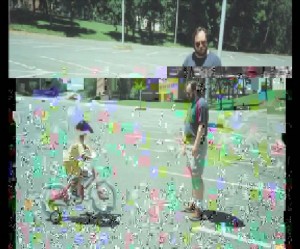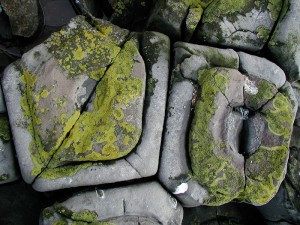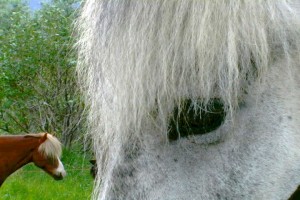MOTHER NATURE / HUMAN NATURE (show 7) – TRT: 23.32
Fighting to compete
[toggle title=”IN RECOVERY; (2013) Alex Hovet; Super 8; TRT: 2.55
In Recovery challenges my father’s memory with my own.
Read more…” status=”progression_closed”]
 This film is constructed from scanned prints of family photographs which I subjected to a randomized glitching process using a program called GoldMosh. The photographs become warped and are degraded as their code is broken down, creating this sporadic digital collage. These documented memories being digitized and degraded by a process over which I have little control echo the physical breakdown of memories after uncontrollable neurological trauma.
This film is constructed from scanned prints of family photographs which I subjected to a randomized glitching process using a program called GoldMosh. The photographs become warped and are degraded as their code is broken down, creating this sporadic digital collage. These documented memories being digitized and degraded by a process over which I have little control echo the physical breakdown of memories after uncontrollable neurological trauma.
My father suffers from short-term memory loss and difficulties as the result of a near-fatal stroke in 2006, when I was 13 years old. In 2013, I began a cycle of films that explore the degradation of image and memory and the physical processes of recovery. This was the first film I made in the series, and it challenges my father’s memory with my own. Our memories are at a crossroads, in which he remembers what I cannot from the beginning of my life, but I can process most of what he cannot in his daily life now. These conflicting experiences compete with standardized medical facts and my own personal recollections of the stroke event. In degrading images from my childhood, which are documented experiences that I cannot remember, I reconcile the fact that my father can still remember them, despite trouble recalling many of his own today. Other pieces in the series explore aspects of creating narrative from anonymous imagery and the recreation of memory from family archives.
[/toggle]
[toggle title=”WORKING WITH NATURE – THIS IS MY SHOW; (2011) Lori Felker; Digi; TRT: 14:44
Working with Nature can be grueling and painful, but your hostess Adrienne is ready and willing to walk you through what it takes to perfect and control your surroundings.
Read more…” status=”progression_closed”]
Your method seems to have a lot of humor to it, this is unusual in experimental films, how did this come about?
I often say that I never write jokes, I’m just drawn to awkwardness, failure and vulnerability. And i like to put these things in a position in which we can enjoy them and learn from them. When you put a character on screen under those circumstances, people find themselves laughing earnestly, empathetically, perhaps giggling at odd juxtapositions, or nervously chuckling out of embarrassment. I want to explore all of these avenues– humor is so ripe and complex.
Humor exists in a natural, common, performative state, an area of human culture that seems to both define and challenge both groups and individuals on a daily basis. Humor is what we reach out for to feel human, to enjoy being human, to communicate something human as we play, interact, anticipate, wait, and realize. I hope that my work sets up situations that contain an intersection between satire, honesty, the uncanny and the nerve-wracking, where one might be able to find the relief of laughter, an audible connection with an audience, or be lost in a guffaw of disbelief.
What was your creative process with these films?, do you write them first?
This Is My Show was sourced from my own and other people’s lists of complaints and pet peeves. I wrote the dialog for the character Adrienne, but I also had to write a normal script, one that I could follow with my gestures. Having memorized both, I would run through the information and hand motions referring to daisies and planting and not over-watering (or whatever) but then I would insert Adrienne’s complaints and commentary on top of these relatively normal gardening poses. And voila! Weirdness.
I like to call this video “TV-shaped”. I’ve done four variations now: gardening, travel, teen science and the news. I plan to do more.
[/toggle]
[toggle title=”ASSUMPTIONS OF YOUR PHANTOM(SY); Karissa Hahn; Super8; TRT: 1:53
The glorious nature of a phantom-like entity, in the midst of vulnerability.
Read more…” status=”progression_closed”]
My work is quite often derived from a text, or it manifests as some reaction to an event – usually concerning desire. All of my work has been created in a hypomanic state of experimentation. I become obsessed with a concept or phrase and then draw out a long narrative that is meticulously researched and planned out. It’s funny though, because these longer films never fully come to fruition.
Instead, I extract one scene or moment from each ‘storyboard’ which then acts as this emblematic entity to the unseen/made narrative. So now I have this archive of chaotic and drawn out chronicles that act only as source material for shorter works.
Assumptions of Your Phantom(sy) was born from a longer film called Fervor Bruise.
I made it when I was 18 and very much in lust. Those first stages of this experience – (when you put others on a pedestal) — where what fueled the work. The immature and hopeless-romantic side of me wanted this piece to act as a line of ciphered communication to one audience member – and that really excited me at the time. Though, now I look back on it and I see it as being derived from my love for Jaques Tati’s use of materials. The mirrors and reflective surfaces in his sets – in relation to the inward reflections of the human body and psyche – really stirred me at the time.
Assumptions was created digitally in post. Its straightforward shot was not anticipated. It was filmed as I was shooting the super 8 to the end of the roll – after filming a long narrative concerning the same subject matter.
Is there more you want to say about your creative process with ‘film’ – which you chose to use over video?
I am currently working only with camera-less filmmaking, where I print out digital videos from the internet onto film using my household printer. So there is video-work occurring, but it only performs as the source material – that essentially gets placed back onto film….as an act of putting images back on film that have been replaced with blu-ray, screened at theaters, and torrented back onto the internet. There is this immediacy with video that is nice, yet I currently strive to make it more tangible – and that is where celluloid plays a role.
[/toggle]
[toggle title=”LANDSLAG; Kyja K-Nelson; mini DV; TRT: 4.00
The gesture of natural forces that physically and metaphysically shape the Skagafjordur region of Iceland.
Read more…” status=”progression_closed”]
How did you make this movie, where was it shot?
Landslag was shot during the summer of 2004, primarily on the northern coast of Iceland in the region of Skagafjordur, from where my family emigrated in the late 1800s. I had studied at the University of Iceland from 2000-2001, traveling quite a bit during that time, but I never spent time in Skagafjordur. During the summer of 2004, I returned to Iceland to do some research for a grant proposal (which later led to the making of my film, Sveit). It took a while to sort out portions of my family history so I visited the Icelandic Emigration Center in Hofsos. While doing that research, I shot some video as part of a travelog. That footage was soon transformed into the film, Landslag.
 How did this film come about and why did you make it?
How did this film come about and why did you make it?
Landslag is the icelandic word for landscape. The film is essentially a documentary (or as some have called it, an avant-doc), meditating on the gestural and natural forces of the area. Thus water and wind feature prominently, as do animals. Human presence is only subtly included, both in the handheld cinematography and a brief sound sample of Icelandic children laughing in the sound design. There are very tranquil moments, where you can see that the wind has helped a plant draw beautiful circles in the sand. And then there are very aggressive moments, for which I chose not to use “clean” sounds of strong Icelandic wind but rather used the sound of wind damaging the sound sample as it hits the microphone and overmodulates. Like most all places on earth, the shift between Iceland’s tranquil and aggressive forces in nature are quite extreme and the shift can happen rapidly.
Is there nything else you want to say about your creative process?
Though I went to Iceland that summer hoping to shoot some footage, I didn’t know at the outset that I would make Landslag. The process was very organic and marks a considerable shift in my filmmaking. Landslag was born out of cinematography and editing (and in fact won awards for both of those aspects), rather than the usual pre-production one would engage in with, say, traditional narrative filmmaking. Thus the production process was very experiential and allowed me to simply play with the camera, light and environment. There was something very freeing about working that way, and that process has followed me since then (for better or worse). Shooting a film that way makes for a lot of work (and often many headaches) for the editor unfortunately. As it turns out, editing is my favorite part of the filmmaking process… however, I remember feeling so overwhelmed by the footage since there was no script or pre-determined story. I spent a lot of time editing. It was a lot of fun, but a lot of work. Out of approximately 4 hours of footage, came Landslag, a 4 minute film!
[/toggle]







